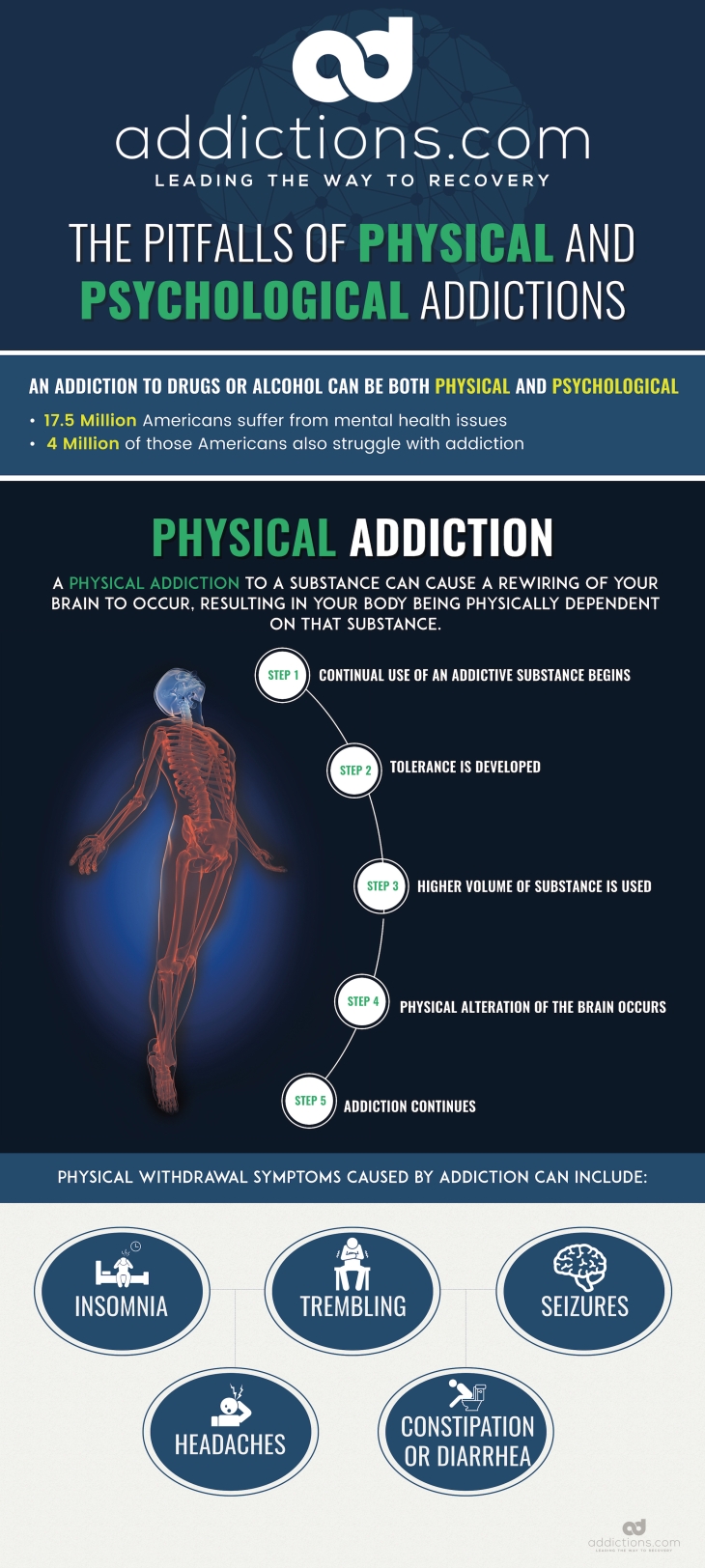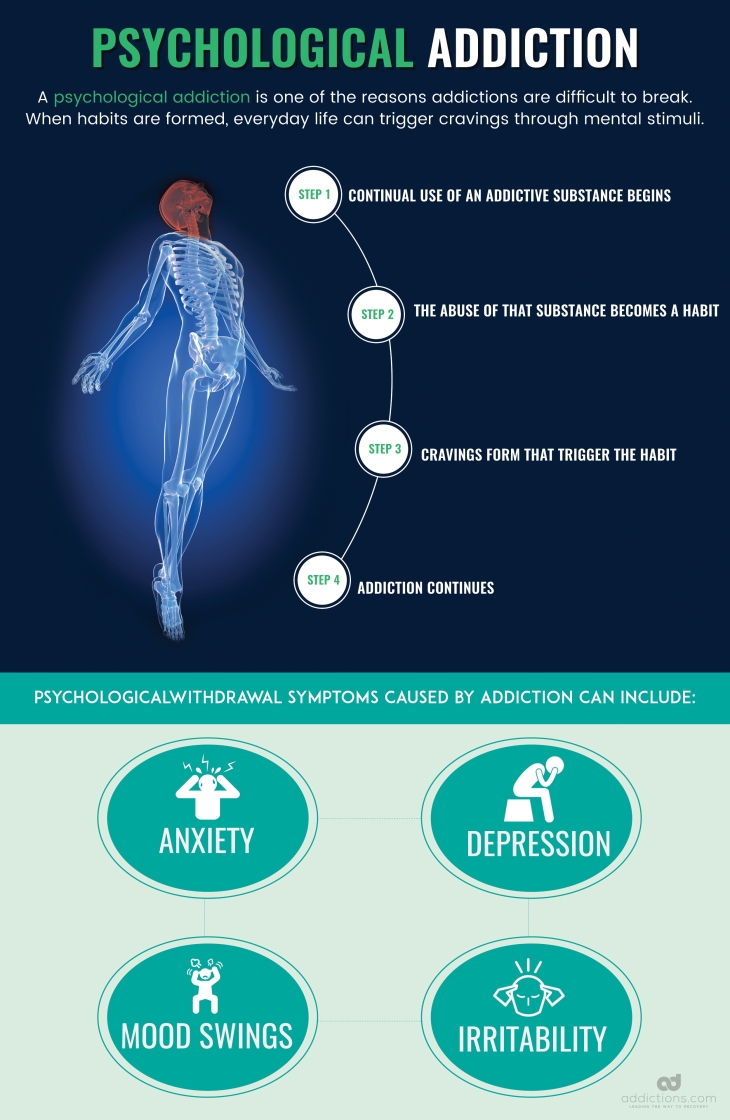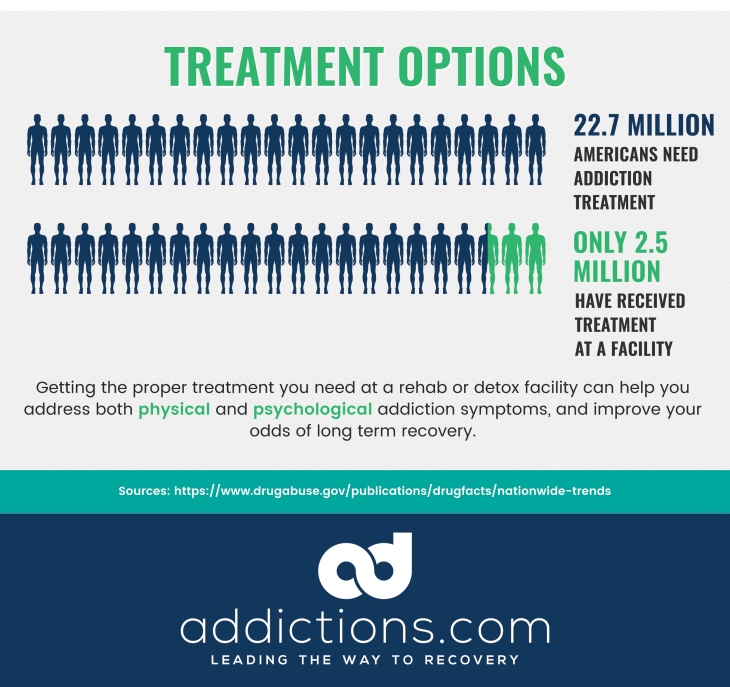Scientific research surrounding addiction has come a long way since the 1930s, which is when researchers initially began hunting for causes of this chronic brain disease. Scientists and doctors back then declared that those who suffered from addiction were morally flawed, and lacked the willpower to quit using. These misconceptions led to a stigma associated with addiction that has lasted for decades, and still exists today despite the fact addiction is officially recognized as a chronic relapsing brain disease.
Addiction can be physical, psychological, or both, in many cases. With repeated, consistent abuse, alcohol and drugs can alter functions in the brain and central nervous system, and go on to trigger physical dependence. An individual is physically addicted to drugs and alcohol when they require these substances to avoid cravings, nausea, and other withdrawal symptoms.
Psychological addiction revolves around one’s behavior, and is defined as a compulsion or perceived need to use drugs and alcohol. Individuals who suffer psychological addiction often use drugs and alcohol to satisfy themselves emotionally and mentally, and to stave off feelings of depression, anxiety, and stress. Psychological addiction is not just limited to alcohol and drug use, and can stem from repeating certain pleasurable activities such as gambling, shopping, and playing video games.
Any addiction type can be effectively treated regardless of whether a person suffers from physical addiction, psychological addiction, or both. Here’s a closer look at the difference between physical and psychological addiction, and at treatments that can help you or your loved one successfully overcome addiction as a whole.
What Triggers Physical Addiction?
Drugs and alcohol affect the brain and body in numerous different ways, depending on the substance. For instance, central nervous system depressants like benzodiazepines help you relax so you can overcome anxiety or sleep problems, while central nervous system stimulants like cocaine increase your energy and heart rate. But all drugs and alcohol increase your brain’s production of dopamaine — a neurotransmitter responsible for delivering feelings of pleasure and reward.
Alcohol and drugs promote the release of dopamine, which influences users to continue abusing these substances to prolong feelings of euphoria, relaxation, and other effects. This can lead to tolerance, which is when a person no longer feels the effects of a substance due to repeated use. When a person becomes tolerant to drugs or alcohol, they start using higher amounts in an effort to achieve its effects.
Tolerance can eventually lead to physical dependence, also known as physical addiction. Those who suffer from physical addiction will experience withdrawal symptoms that range from mild to severe when reducing drug use or quitting cold turkey. Withdrawal symptoms occur when cells in the body and brain are forced to readjust and regain normal function after growing accustomed to drugs and alcohol.
Common drug and alcohol withdrawal symptoms:
- Dilated or constricted pupils
- Nausea and vomiting
- Sweating
- Shaking
- Insomnia
- Fatigue
- Muscles aches and pains
- Irritability
- Irregular heart rate
- Anxiety
- Depression
Physical addiction can develop more quickly in some individuals than in others, based on factors such as the substance being used, the amount being used, and on whether the substance is being injected, smoked, or taken orally. For instance, those injecting a potent, highly addictive substance like heroin on a regular basis can become physically addicted to the drug after a matter of days.
What is a Psychological Addiction?
Psychological addiction is closely linked to physical addiction in that it is also driven by increased dopamine production in the brain. Those who enjoy the effects of drugs and alcohol, or who suffer from behavioral addictions will continue using those substances and engaging in those behaviors on behalf of increased dopamine levels. Psychological addiction occurs when drug abuse and harmful behaviors are prioritized above important obligations, and become central to an individual’s emotions, thoughts, and daily activities.
Those who suffer from psychological addiction often believe they need to engage in certain behaviors to feel good and achieve euphoria despite the negative consequences associated with those particular behaviors. For instance, an individual who suffers from marijuana addiction may feel that they are unable to relieve anxiety without using the drug, while those who suffer from shopping addiction may feel as though shopping is the only way they can effectively relieve depression.
Psychological addiction often causes changes in one’s behaviors and thought patterns. This addiction type is commonly marked by cravings, which can occur years after someone has quit drugs and alcohol or overcome behavioral addiction. Cravings are generally defined as a powerful desire for something — such as the euphoria produced by drugs and alcohol, or the rush of dopamine experienced when passing a challenging level on a video game.
Common signs and symptoms of psychological addiction:
- Intense cravings to use drugs and alcohol
- Denial about problems associated with addiction
- Feelings of depression and anxiety when trying to quit drugs and alcohol
- Feelings of anxiety about not having access to drugs and alcohol
- Feelings of restlessness when quitting or not using drugs and alcohol
- Being unable to cope without using drugs and alcohol
- Mood swings and irritability
- Insomnia when unable to use drugs or perform the addictive behavior
- Spending excess money and time on buying and using drugs
- Ongoing fantasies about using drugs or performing the addictive behavior long after quitting
- Loss of memory and confusion
- Tolerance to drugs, alcohol, and certain behaviors
Problems associated with psychological addiction are just as serious as those associated with physical addiction, and should be treated to lower the risk for depression, suicidal ideation, and cognitive health conditions like Dementia and Alzheimer’s disease. Psychological addiction can negatively impact one’s overall quality of life, and lead to relapse and other major problems down the road when left untreated.
Common Physical and Psychological Addiction Types
Many people commonly associate the term “addiction” with drug and alcohol abuse, but behavioral addiction is also very widespread. In the United States, alcohol has the highest rate of dependence or abuse among all substances, while marijuana ranks second and is becoming more widely used on behalf of legalization across the country. Other common physical addictions are that to opioids, sedatives, stimulants, and hallucinogens.
In cases of drug and alcohol addiction, each substance produces its own unique effects that may appeal to some individuals more than others. For instance, those seeking an intense energy rush may choose to abuse stimulants like cocaine and Adderall, while those seeking a more relaxed feeling of sedation may abuse opioids like heroin and oxycodone.
Behavioral addictions are often triggered by factors such as genetics and personality, and often coincide with substance abuse. Examples of behavioral addiction include addiction to sex, exercise, and video games.
Here are common physical and behavioral addiction types:
- Alcohol. About 15.1 million adults in the U.S. are addicted to this legal sedative.
- Opioids (e.g., heroin, oxycodone, fentanyl). Heroin and prescription painkillers were responsible for over 33,000 overdose deaths in the U.S. in 2015.
- Sedatives (e.g., benzodiazepines, barbiturates, sleep aids). These drugs cause drowsiness and sleepiness, and are commonly prescribed to treat anxiety and sleep disorders.
- Stimulants (e.g., cocaine, MDMA, Ritalin). These substances stimulate the central nervous system by increasing blood pressure, glucose, and heart rate, and constricting blood vessels.
- Hallucinogens (e.g., PCP, LSD, bath salts). These synthetic substances alter perception, thoughts, and feelings, and generally cause hallucinations and feelings of physical and psychological disconnection.
- Gambling. Roughly 2.5 million adults in the U.S. suffer from compulsive gambling.
- Sex. Those who suffer from sex addiction report being unable to control certain sexual thoughts and actions.
- Eating. Common eating disorders are anorexia nervosa, bulimia nervosa, and binge eating.
- Video games. This addiction type can lead to behavioral and social development problems, especially in children and teens.
- Shopping. Signs of shopping addiction include overspending, compulsive purchases, and lying to friends and family about shopping and spending habits.
- Risky behavior. This addiction type involves the performance of dangerous high-risk activities such as having unprotected sex with strangers and driving while intoxicated.
All addiction types, including behavioral addictions, can be effectively treated at drug and alcohol rehab centers using detoxification and counseling. Many addiction treatment centers are devoted to helping individuals overcome addiction as a whole both physically and psychologically using these therapies.
How Physical Addiction is Commonly Treated
Physical addiction is commonly treated using detoxification. Detox treatments help individuals withdraw from drugs and alcohol so they are no longer physically dependent on these substances. Detox can be performed one of several ways, depending on the severity of an individual’s addiction, the substance being used, and on the patient’s personal treatment preferences.
Many of today’s detox treatments are designed to reduce or eliminate common withdrawal symptoms triggered when quitting drugs and alcohol. Those who try quitting drugs and alcohol on their own cold turkey often experience severe withdrawal symptoms that cause great discomfort, such as nausea, vomiting, and insomnia. These individuals will often resume alcohol and drug use in an effort to relieve their symptoms — increasing the risk for relapse, overdose, and death.
Detox treatments lower a patient’s risk for relapse following treatment, and can minimize the risk for serious health complications that may occur when withdrawing from drugs and alcohol outside of a controlled medical environment.
Here are common drug and alcohol detox methods:
- Medically supervised detox. Patients withdraw from drugs and alcohol in a safe, controlled medical environment, and are supervised by medical staff 24/7 during withdrawal to minimize the risk for complications. Medical detox may involve the use of prescription medications that relieve or reduce withdrawal symptoms such as anxiety and insomnia.
- Natural / holistic detox. Patients withdraw from substances naturally without the use of medications. Natural and holistic detox often involves exercise and nutrition therapy, and may involve alternative therapies such as acupuncture, daily massage, and IV vitamin therapy.
- Medication-assisted treatment. Those who suffer from heroin and painkiller addiction can detox from opioids slowly by taking FDA-approved medications that mirror the effects of opioids without producing euphoria, and that reduce withdrawal symptoms. Medication-assisted treatment can last for several weeks or months, and involves the use of methadone, buprenorphine, or Suboxone.
- Tapering. This detox method is commonly used to help patients overcome addiction to prescription drugs including benzodiazepines, stimulants, and sleep aids. Tapering is when doctors gradually reduce a patient’s dosage of the substance over time until they are no longer physically dependent on the medication.
How Psychological Addiction is Commonly Treated
Psychological addiction is often treated using a combination of one or more therapies designed to promote lifelong sobriety from drugs, alcohol, or the addictive behavior. Those who also suffer from physical addiction will go through drug and alcohol detox first before starting psychological therapy. This allows patients to improve their physical and mental health so they can successfully address the root causes of their addiction with continued therapy.
Most addiction treatment centers will customize therapies for each individual patient based on their personal recovery needs. For instance, those who have strained family relationships can benefit greatly from family therapy, which teaches family members the ins and outs of addiction, and about how to communicate more effectively with one another.
Here are common therapies for psychological addiction:
- Individual counseling. Patients meet one-on-one with therapists to identify and overcome the root causes of their addiction.
- Group counseling. Group therapy allows patients to bond with others in recovery who share similar struggles with addiction, and to openly discuss their thoughts and emotions surrounding addiction.
- Family counseling. Families affected by addiction can learn more about causes and behaviors associated with addiction so they can help their loved ones achieve lasting sobriety.
- Experiential therapy. These therapies focus on experiences that help patients address, cope with, and overcome psychological addiction. Examples of experiential therapy include equine therapy, art therapy, and wilderness therapy.
- Cognitive-behavioral therapy. CBT helps patients identify and overcome negative behaviors and thought-processes driving their addiction.
- Contingency management intervention. Patients who remain abstinent from drug and alcohol use are given rewards in the form of vouchers, gift certificates, and other prizes to encourage and reinforce sobriety.
- Twelve-step support groups. Alcoholics Anonymous and Narcotics Anonymous are common 12-step facilitation therapies that teach patients how to recover from substance abuse and stay sober for life.
Many therapies for psychological addiction are usually offered in aftercare programs for patients who want ongoing treatment to maintain lifelong sobriety. Patients who receive ongoing addiction treatment in the form of 12-step support groups and relapse prevention education often fare best with sobriety, and learn tips and tricks needed to handle themselves in situations that could lead to relapse.



